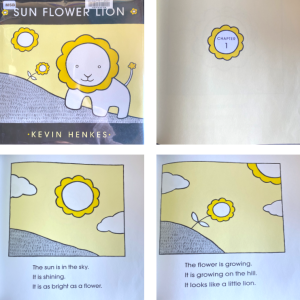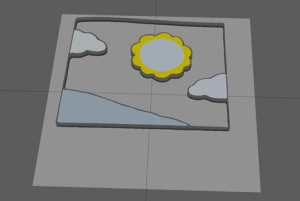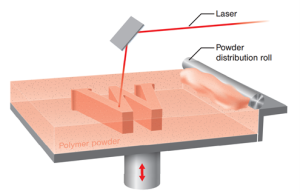OVERVIEW
Goal
The goal of the project is to convert children’s books into a form that visually impaired / blind children can interact with. Using additive manufacturing in the form of various geometries and textures, the team hopes to bring classic children’s books “to life” by converting traditional picture books into a form that can be experienced by touch alone . The Sun Flower Lion children’s book written by Kevin Henkes was selected to recreate. If time permits, an Arduino system will be used to read the pages out to the user so that they can feel the images and listen to the book at the same time.
Why
To allow for visually impaired/blind children to fully experience existing children’s books. Many children’s books are focused on bright colors and interesting visuals. The team will create a medium where blind/visually impaired children can experience those same stories using various textures and outlines of objects, as well as converting text to braille.
PRELIMINARY PLAN
Design features
Our group goal is to create a three-dimensional version of Kevin Henkes’s picture book. Henkes’s book, “Sun Flower Lion,” is what we plan to create. After comparing various books available at the local library, the team settled on this book for the first design iteration because of its simple shapes and well-defined lines. Sample pages from the book can be seen below in Figures 1 – 4.
Figures 1-4: Example pages from ‘Sun Flower Lion’ by Kevin Henkes
The book will be scanned, or preferably, an online PDF version will be acquired. PDF versions are preferred as they are exact compared to scanned copies. Once we have copies, the team must determine a method of converting book images to topographically elevated images. One option is using vector images (SVG files) to convert the pictures into lines. The goal with vector images is to extract the color and line data to create 3D versions on the files through CAD programs. Another option is converting pdf or png files into grayscale maps using programs similar to Adobe Illustrator. The program Autodesk Maya can easily create a topographic elevation of grayscale images. An image would be inserted onto a plane and elevated based on the grayscale value. We can insert the images files and manually pull the sections to create the necessary elevation using functions within Maya. Figure 5 below is an example of a png file converted into a 3D file in Maya.
Figure 5: A page of Henkes’s book extruded in Autodesk Maya
Next, we want to create design features that differentiate the various colors. One approach is texturing areas depending on color. An example of this in the book would be adding texture to regions that contain grass or making flat objects feel smooth. Adding different textures would simulate the differences in color that the author is trying to portray. This idea could also be applied to different items specifically. While a sun and a lion’s mane are both yellow, different textures should be applied to these items.
Converting the text to Braille is another aspect of our design. A visually impaired person relies on a braille to read. The group will decide whether to keep the English text. If the English text is kept, a sighted guardian could read to the child.
Lastly, the group hopes to implement an Arduino reading system within the book, if time permits. Ideally, the pages could be turned, and the Arduino system reads to the child in a recorded voice. The recorded voice could be of their parent or guardian. A device that recognizes a page being turned could be used. Or a button could be pressed on each page to begin the recording. The system would be profitable as it would allow the child to listen to the words and practice, along with the enjoyment of listening to the book.
Manufacturing Method
The method we preliminary plan to use is Selective Laser Sintering (SLS). A diagram of SLS can be seen below in Figure 6 [A].
Figure 6: Diagram of SLS process
SLS can manufacture an “0.08 – 0.2″mm thick layer,” height [A]. This is a close to common paper width of approximately 0.04 mm. The higher resolution will allow us to be able to include textures and other detailed features within the book. An advantage to SLS is the capability of manufacturing multiple pages at once. The pages can be stacked on top of each other, with powder between the pages. One disadvantage to SLS is the rougher surface finish. We will use material provided for us in the Polymer Engineering Center.
Standard FFF process could also be used in the prototyping phase of the project to test designs before they are printed through SLA. Printing with SLA will be reserved for creating final versions of the pages due to potential cost constraints.
NEXT STEPS
The next steps for the project involve contacting the Wisconsin Council of the Blind and Visually Impaired in order to discuss our design ideas and final product outcome. The ability to receive direct feedback during our design process from someone who is visually impaired is critical to the viability of this project. Additionally, a partnership with this organization would help expose this idea to a larger group of users who could test and provide feedback on improvements, which would help guide the direction of the project.
Our group would also like to ensure everyone has access to all required hardware and software that will be necessary to carry out design and testing. We will also work with various scanning / file conversion methods to determine the best method for converting the pages of the book into 3D files.
Additionally, we will look into other additive manufacturing methods during the course and reevaluate if SLS is an optimal method. Outside of using the Polymer Engineering Center for manufacturing, the Makerspace will be used for producing prototypes through SLA of FFF methods.
Lastly, we will generate a schedule with deadlines, specific deliverables, and team meeting times.
REFERENCES
- Sun Flower Lion Written and illustrated by Kevin Henkes. “Sun Flower Lion: Kevin Henkes.” Kevin Henkes – Official Website, 19 Oct. 2020, https://kevinhenkes.com/picture-books/sun-flower-lion/.
- A. T. A. Osswald, Understanding polymer processing, 2nd ed. Hanser, 2018


